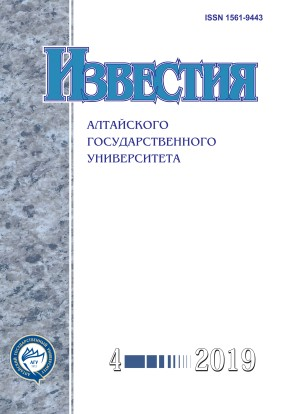The Structure and Properties of Materials Based on Alloys and Thin Films of Niobioum with Tin
УДК 546.8:661.88
Abstract
The structure and properties of materials based on alloys and thin films of niobium with tin were investigated by means of differential thermal (DTA), X-ray, energy dispersive analysis. The synthesis conditions and temperature ranges of oxidation resistance were determined from the DTA data. The study of the stability of films in the air was carried out when keeping the films at room temperature for 1-3 months and when heating them at 100 and 250 ° C for 2 hours. Alloys were obtained by direct fusion of the components at 800 ° C with further grinding, pressing, and sintering at 500 ° C for 100 hours. The phase composition of the alloys was investigated by the X-ray phase analysis. X-ray phase analysis of thin films showed that thermodynamically most stable compounds in the system are usually deposited on the surface of the substrate during deposition from the gas phase. The study of the surface relief using an AFM atomic force microscope showed that the surface of the films remains unchanged when exposed to a normal temperature of up to 3 months. The resistance values determined by the four-probe method demonstrated the increase of resistance of the films by about 20-30% when compared to compact substances.
Downloads
Metrics
References
Godeke A., ten Haken B., ten Kate H.H.J. The Deviatoric Strain Descriotion of the Critical Properties of Nb3Sn Conductors // Physica C. 2002. 372-376 (3).
Taylor D.M.J., Keys S.A., Hampshire D.P E-J. Characteristics and n-Values ofa Niobium-Tin Superconducting Wire as a Function of Magnetic Field, Temperature and Strain // Physica C. 2002. 372-376 (3).
Awaji S., Watanabe K., Nishijima G., Katagiri K., Miyosh, K., Meguro S.-i. Enhancement of Critical Current Densities by the Prebending Strain at Room Temperature for Nb3Sn Wires // Japan. J. Appl. Phys. 2003. 42 (10A). L. 1142- 1144.
Patancar S.N., Froes F.H. Formation of Nb3Sn Using Mechanically Alloyed Nb-Sn Powder // Solid State Sci. 2004. 6 (8).
Mannan S.H., Clode M.P, Dagher M. Study of Intermetallic Crystal Growth Between Nb and Molten 52In-48Sn Solder // J. Electron. Mater. 32 (2). 2005.
Vassilev G. Systematic of binary phase diagrams, formed by low-melting elements (Bi, Sn, Zn, In) and the metals of IV-th and V-th periods // J. Min. Metall. B Metall. 2005. 41 (1).
Okamoto H. Nb-Sn (Niobium-Tin). //J. Phase Equilibria 2003. 24 (4).
Scheuerlein C., Di Michiel M., Haibel A. On the formation of voids in internal tin Nb3Sn superconductors // Appl. Phys. Lett. 2007. 90 (13). 132510-132510-3.
Popova E.N., Sudareva S.V., Romanov E.P et al Effect of Alloying on the Structure of Bronze with Enhanced Tin Content // Phys. Met. Metallogr. 2007. 103 (2).
Pong I., Hopkins S., Fu X. et al. Micro structure development in Nb3Sn(Ti) internal tin superconducting wire // J. Mater. Sci. 2008. 43 (10).
Escudero R., Morales F., Bernes S. Specific heat studies of pure Nb3Sn single crystals at low temperature // J. Phys.: Condens. M3atter. 2009. 21 (32). 325701.
Aleksashin B.A., Soloninin A.V., Korolev A.V et al. Investigation into nanocrystalline Nb3Sn layers structure in multifilamentary superconductors of different geometry using NMR and magnetic susceptibility methods // Inorg. Mater.: Appl. Res., 2010. 1 (1).
Novosilova D.S., Abdyukhanov I.M., Vorob'eva A.E et al. Influence of diffusion annealing on residual resistivity of Nb3Sn-based chromium-plated strands obtained by a bronze process // Phys. Met. Metallogr. 2012. 113 (10).
Deambrosis S.M., Keppel G., Ramazzo V. et al. A15 superconductors: An alternative to niobium for RF cavities // Phys. C (Amsterdam) 441. 2006.
Соколовская Е.М., Гузей Л.С. Металлохимия. М., 1986.
Webb G.W., Fisk Z., Engelhardt J.J., Bader S.D. Apparent T2 dependense of the normal state resistivites and lattice heat capacites of high-Tc supercoductors // Phys. Rev. B: Solid state. 1977.
Guseva I.A., Seropegin Y.D., Sokolovskaya E.M. The properties of zirconium-doped Nb3Sn-Nb3Ge solid solutions // J. Less-common Metals. 1982. 87.
Izvestiya of Altai State University is a golden publisher, as we allow self-archiving, but most importantly we are fully transparent about your rights.
Authors may present and discuss their findings ahead of publication: at biological or scientific conferences, on preprint servers, in public databases, and in blogs, wikis, tweets, and other informal communication channels.
Izvestiya of Altai State University allows authors to deposit manuscripts (currently under review or those for intended submission to Izvestiya of Altai State University) in non-commercial, pre-print servers such as ArXiv.
Authors who publish with this journal agree to the following terms:
- Authors retain copyright and grant the journal right of first publication with the work simultaneously licensed under a Creative Commons Attribution License (CC BY 4.0) that allows others to share the work with an acknowledgement of the work's authorship and initial publication in this journal.
- Authors are able to enter into separate, additional contractual arrangements for the non-exclusive distribution of the journal's published version of the work (e.g., post it to an institutional repository or publish it in a book), with an acknowledgement of its initial publication in this journal.
- Authors are permitted and encouraged to post their work online (e.g., in institutional repositories or on their website) prior to and during the submission process, as it can lead to productive exchanges, as well as earlier and greater citation of published work (See The Effect of Open Access).








